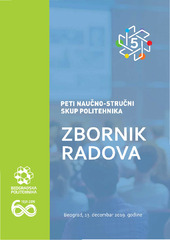Приказ основних података о документу
Određivanje veštačkog zaslađivača saharina u uzorcima otpadne vode
Determination of artificial sweetener saccharin in wastewater samples
| dc.creator | Gvozdić, Eleonora | |
| dc.creator | Matić Bujagić, Ivana | |
| dc.creator | Đurkić, Tatjana | |
| dc.creator | Grujić, Svetlana | |
| dc.date.accessioned | 2023-02-28T13:42:07Z | |
| dc.date.available | 2023-02-28T13:42:07Z | |
| dc.date.issued | 2019 | |
| dc.identifier.isbn | 978-86-7498-081-1 | |
| dc.identifier.uri | http://TechnoRep.tmf.bg.ac.rs/handle/123456789/5935 | |
| dc.description.abstract | Široka primena veštačkih zaslađivača u prehrambenoj i farmaceutskoj industriji počela je početkom osamdesetih godina prošlog veka. Većina ovih jedinjenja se ne metaboliše u ljudskom telu i izlučuje se uglavnom nepromenjena. Glavni izvor veštačkih zaslađivača u životnoj sredini predstavljaju komunalne otpadne vode. Zbog ograničenih podataka o njihovoj ekotoksičnosti i ponašanju u životnoj sredini, svrstani su u klasu emergentnih zagađujućih materija. Dosadašnja istraživanja su pokazala široku rasprostranjenost ovih jedinjenja u površinskim i podzemnim vodama. U ovom radu je razvijena i optimizovana metoda pripreme uzoraka otpadne vode ekstrakcijom na čvrstoj fazi za analizu veštačkog zaslađivača saharina. Izvršen je odabir optimalnog sorbenta, pH vrednosti i zapremine uzorka vode, kao i rastvarača za eluiranje saharina sa pakovanja kolone. Dobijeni ekstrakti su analizirani metodom tečne hromatografije sa tandem masenom spektrometrijom. Razvijena metoda je primenjena na uzorke otpadnih voda iz tri kanalizaciona ispusta u Beogradu i okolini. Detektovane koncentracije saharina su bile u opsegu od 2,9 µg L–1 do 13,5 µg L–1. | sr |
| dc.description.abstract | The widespread use of artificial sweeteners in the food and pharmaceutical industry started at the beginning of the 1980s. Most of these compounds are not metabolized in human body and are excreted mostly unchanged. Communal wastewater is the main source of artificial sweeteners in the environment. Due to limited data on their ecotoxicity and fate in the environment, they are classified as emerging pollutants. Previous research has shown the wide distribution of these compounds in surface and ground water. In this paper, the method of preparation of wastewater samples was developed and optimized using the solid-phase extraction for the analysis of artificial sweetener saccharin. The sorbent type, the pH and the volume of the water sample, as well as the elution solvent were tested in the sample preparation optimization. The obtained extracts were analyzed by liquid chromatography–tandem mass spectrometry. The developed method was applied to wastewater samples collected from three sewage discharges in Belgrade and the surroundings. The detected concentrations of saccharin were in the range from 2.9 μg L–1 to 13.5 μg L–1 . | |
| dc.language.iso | sr | sr |
| dc.publisher | Beograd : Beogradska politehnika | |
| dc.relation | info:eu-repo/grantAgreement/MESTD/Basic Research (BR or ON)/172007/RS// | sr |
| dc.rights | openAccess | sr |
| dc.rights.uri | https://creativecommons.org/licenses/by/4.0/ | |
| dc.source | Zbornik radova / Peti naučno-stručni skup Politehnika 5, Beograd, 13. decembar 2019.godine | sr |
| dc.subject | veštački zaslađivači | sr |
| dc.subject | otpadna voda | |
| dc.subject | ekstrakcija na čvrstoj fazi | |
| dc.subject | tečna hromatografija–tandem masena spektrometrija | |
| dc.subject | artificial sweeteners | |
| dc.subject | wastewater | |
| dc.subject | solid-phase extraction | |
| dc.subject | liquid chromatography–tandem mass spectrometry | |
| dc.title | Određivanje veštačkog zaslađivača saharina u uzorcima otpadne vode | sr |
| dc.title | Determination of artificial sweetener saccharin in wastewater samples | |
| dc.type | conferenceObject | sr |
| dc.rights.license | BY | sr |
| dc.citation.epage | 224 | |
| dc.citation.spage | 220 | |
| dc.identifier.fulltext | http://TechnoRep.tmf.bg.ac.rs/bitstream/id/20039/Determination_of_artificial_sweetener_pub_2019.pdf | |
| dc.identifier.rcub | https://hdl.handle.net/21.15107/rcub_technorep_5935 | |
| dc.type.version | publishedVersion | sr |

